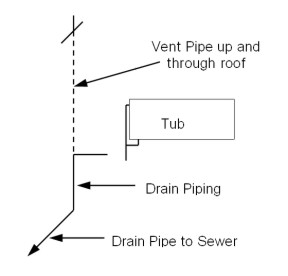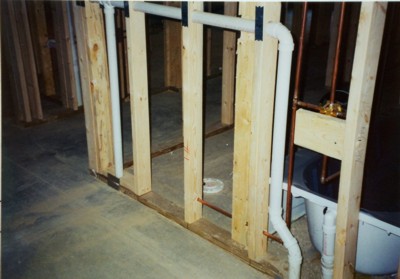Sometimes, there is nothing more aggravating than low water pressure. In some instances, it can even be dangerous. Low water pressure problems are so commonplace that the national plumbing codes mandated, several years back, the use of pressure balanced shower valves to minimize injury caused by low water pressure problems.
There is a misconception by many homeowners that low water pressure is something they have to live with. Nothing could be further from the truth! Many low water pressure problems are a result of installation inadequacies. The plumber(s) simply put piping in that was either too small (undersized) or reduced the size of the piping, within a structure, too quickly.
Low water pressure problems can also be attributed to scale deposits inside of piping which reduce their diameter, low pump pressure (houses with wells), leaks in underground lines serving a house, and problems with outdated water mains in municipal systems (rare). These problems can usually be identified very quickly. Municipal water works companies have trained personnel that will visit your house and answer questions regarding your water service. Often it takes very little detective work to determine if one, or several, of these possibilities is the source of your low water pressure. Almost always they will help you determine if there is an underground leak, at no charge to you.
They can also attach a pressure reading device which will tell you just what the water pressure is inside your house when all fixtures are turned off.
You can also stop by your local firehouse. Fire engines are equipped with accurate pressure gauges. When a fire engine attaches to a fire hydrant, before they start pumping water from the hydrant they know what the water pressure is in that water main.
By the way, in case you didn't realize it, the fire hydrants on your street are hooked to the same water main you drink from. The only deviation from this is in some large cities. There are individual water mains specifically for fire fighting, but these are almost always located in dense urban/business environments.
The fire departments often have very specific records and they can tell you the specific pressure of the fire hydrant closest to your house. Stop by and chat with them, you may be surprised at what they can tell you about the water mains in your area!
Robert Boyle
Robert Boyle was an English chemist born in 1627. He was a pretty smart guy. Well educated and very methodical, he started experimenting with gases. He developed Boyle's Law which has to do with the relationship between a given volume of gas and its pressure.
He determined that liquids acted somewhat differently. It didn't take too long for him to determine that water couldn't be easily compressed. In fact, it was virtually impossible.
What he found out was that when you applied pressure to water (liquids) in a closed system (no leaks), whatever pressure you applied, the same pressure was exerted everywhere by the liquid against the container it was in.
This is a very significant finding. It tells you that when all of your faucets are closed in your house, the pressure within your plumbing system should be equal everywhere. Not only that, if you happened to visit your local fire department and/or call the water works, you will know what that pressure should be. The only deviation will be the resultant pressure drop due to friction loss as the water travels from the street into your house.
Those people who operate using well water and electric pressure pumps operate under the same "laws". The only difference is pump capacity. Smaller pumps simply cannot meet the demand (flow) you might impose upon them. They may be able to produce an adequate pressure (50 - 70 pounds per square inch PSI), but when asked to deliver lots of water at this pressure, they choke. You may have to jump to a bigger pump.
This is rarely the problem with a municipal system. The typical water main in a residential street can deliver hundreds of gallons per minute and maintain pressure. To put this in perspective with respect to your own water usage, you might use seven gallons per minute if you had four people using two separate bathrooms at the same time. This situation is somewhat realistic as people get up to go to work and school.
Friction Loss
OK, so we know that the pressure in a closed system is constant because of Bob Boyle's findings. What then accounts for water pressure / volume losses?
Well, a number of things can contribute to water pressure loss. Some of the major items are relative elevation differences between your house (fixtures) and the water main, size of water piping and restrictions in a pipe. The two most likely culprits in most cases are the last two, water pipe size and restrictions. These two items have a huge impact on friction loss. Friction loss can dramatically affect water pressure. What happens is simple. When water starts to flow through a pipe, some of it rubs against the side of the pipe. Depending upon how much water is rubbing against the inside walls of the pipe in relation to how much water is in the pipe in any given length, determines how great the pressure loss will be.
The technical term for this situation is called the hydraulic radius. But who cares about that, let me show you a simple example.
Bigger is Better
Let's look at a cross section of a 1/2 inch inner diameter copper pipe. Remember that grade school math homework you didn't do??? Well, it's payback time!
The inner circumference of the 1/2 inch pipe is 1.57 inches. The area of the cross section of this same pipe is 0.19 inches.
Let's look at a 3/4 inch pipe. It's inner circumference is 2.35 inches. It's cross sectional area is 0.44 inches.
Now, these numbers may seem either confusing or insignificant. But, look a little closer. Notice that when we jumped to 3/4 inch pipe, a funny thing happened. The circumference increased by 49.6 percent. But, the cross sectional area increased by 131.5 percent!
This means that as a pipe gets bigger, there is more room to move around. Not as much of the fluid in the pipe has the opportunity to rub against the sides of the pipe.
Restrictions inside pipes can also cause friction loss. Imagine a rough scalely pipe. The water trying to get from one end to the other hits and rubs against lots of "things". It loses energy. What's more, the deposits inside the pipe reduce its inner diameter. As shown above, small inner diameter pipe causes great pressure loss because of friction loss.
So, with respect to pipe size and pressure, bigger is better!
Column B372


